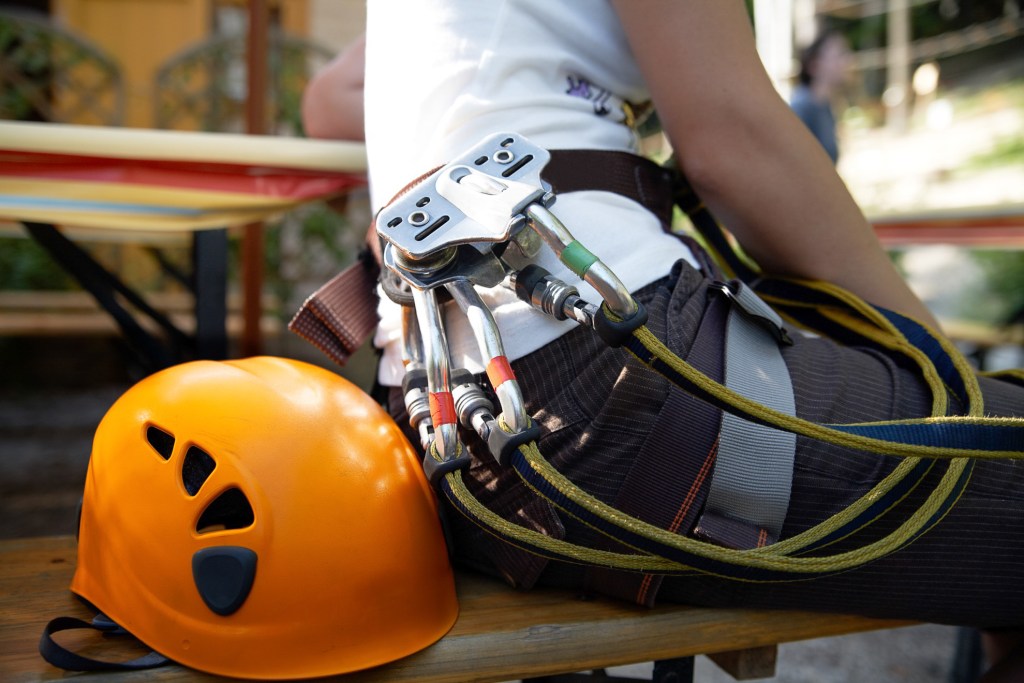Note: The Travel Awaits team regularly updates content to provide the latest, and most accurate information to our readers. The updated content in this article may not reflect the views or opinions of the original author.
There’s nothing quite like your first zip-line experience. You pop on a helmet and a harness, clip into the trolley, and stand at the edge of a platform. Somehow, it’s a lot higher from up there than it looked from the ground. But after working up the courage, you take a deep breath, grip the handles, and leap from the platform.
Zzzzzzhhhhhhhhhhh — the trolley whistles as it glides on the zip line. You fly over the treetops before the brakes kick in and you slow to a halt. The guides pull you in to safety on the next platform. Exhilarated, you can’t believe your first zip-line ride ended so quickly — and you’re ready for the next one.
Zip-lining is one of those quintessential adventures every thrill-seeking traveler should experience at least once. The US witnesses a surge in ziplining’s popularity. The Global Adventure Tourism Market Report forecasts a $2 billion growth in the ziplining market by 2030. This trend fuels tourism in states like California, Colorado, and North Carolina, renowned for abundant outdoor activities and thriving ziplines.
Looking to try it on your next trip? Here’s what you need to know before you zip-line for the first time.
What Is Ziplining? – 9 Things To Know Before You Try It For The First Time
1. Is Zip-Lining Safe?
By and large, ziplining has a reputation for being both fun and safe. However, there are some risks associated with riding a zip line that everyone should be aware of. A 2015 study looked at data from the National Electronic Injury Surveillance System and found that there were 16,850 zip-line-related injuries between 1997 and 2012. Almost half of the zip-line injuries occurred in people 9 years old and younger, and the majority of the injuries were the result of falls. Deaths, while rare, have also happened on zip lines.
A little proactivity can go a long way toward keeping yourself safe at a zip-line course. First, be discerning when it comes to where you choose to zip-line. Regulation from state to state varies, and there are no countrywide standards for constructing and operating zip lines. If you’re considering booking an experience at a particular place, it’s worth picking up the phone to ask how they train their staff, how frequently they inspect their courses, what kind of safety record they have, and whether they adhere to safety standards set by industry organizations such as the Professional Ropes Course Association or the Association for Challenge Course Technology. Only move forward with a company whose answers make you confident in your safety.
When you’re on the zip-line course, pay attention. Follow rules on any signage, and listen to the staff’s instructions. Keep your safety gear on at all times. And if you ever have any concerns about the zip-line course, mention them to the staff.
All of that being said, zip-lining is an extremely popular outdoor activity. Tens of thousands of people have a safe experience on zip lines every year. Do your due diligence, follow directions, and you’ll likely be fine.
2. How Scary Is Zip-Lining?
As someone who has tried 20 or so zip lines around the world, I’ll be honest: It’s scary. Not terrifying, but zip lines will definitely make your heart pound. The scariest part of ziplining is jumping off the platform. You have to fight your natural instincts and put trust in your guides and gear to finally make that jump — but it’s worth it. You’ll feel completely free as you defy gravity and zoom over the trees, the wind blowing in your hair and your feet dangling below. You’ll find the experience so exhilarating that you’ll want to clip into the next zip line and take off again as soon as you finish your first ride.
3. What’s The Weight Limit For Zip-Lining?
It’s common for zip-line operators to boast that their equipment is capable of holding a truck. However, their zip lines usually still come with weight restrictions in order to protect guests. A rider who’s too light might inadvertently stop in the middle of the zip line, making for a less-than-optimal experience. Riders who are too heavy may hit the landing platform too quickly, which could potentially cause injuries.
Generally speaking, zip-line riders should be between 60 and 275 pounds. Some courses have limits on waist circumference as well. Ask your operator about his or her course’s specific restrictions.

4. What Should You Wear For Zip-Lining?
Your clothes will have a direct impact on how comfortable you are throughout the zip-line tour. Wear breathable layers that you can easily move around in. Long shorts, trousers, leggings, or capri pants will give you some padding against the harness and make the ride more comfortable. On warmer days, throw on a T-shirt or tank top. A long-sleeved shirt or sweatshirt might be a better option in cooler weather. Opt for close-toed shoes, like hiking boots or sneakers — flip-flops and sandals are a no-no on many zip lines since they’re prone to falling off in the air. You should also avoid accessories and garments (like scarves, hats, and long necklaces) that could get tangled in the zip-line trolley or fly off during the ride. If you wear glasses, secure them around your neck with a cord. As for safety gear, your guide will provide all the protective equipment you’ll need for safe ziplining.
5. Do You Have To Be In Shape To Ride A Zip Line?
Haven’t hit the gym in a while? Don’t sweat it — ziplines are friendly to people of many levels of physical ability. While you will grip the handles, you’re actually supported entirely by the harness, so you won’t be exerting any upper-body strength to hold yourself up. You may experience a little bit of stress on your ankles and knees as you climb from the zip line to the landing platform, but guides typically reach out to help riders during that process. The most physical activity required is walking between the zip lines. Some ziplining courses involve short hikes, stairs, and suspension bridges. Check with the owners to see what their specific courses entail.

6. How Fast Are Zip Lines?
The speed at which you fly down the zip line is one of the most thrilling parts of the experience. Zip World in North Wales is reputed to have the world’s fastest ziplining ride, hitting top speeds of 125 miles per hour. Most zip lines are a lot tamer, though. According to a survey by Head Rush Technologies, which sells zip-line equipment, 31 to 40 miles per hour was the most frequent top speed achieved by riders. Many others experienced zip-line rides between 21 and 30 miles per hour and 41 and 50 miles per hour.
7. How Do You Stop On A Zip Line?
There are two main types of braking systems on a zip line: passive and active. As the name implies, passive-braking zip lines use speed-reduction mechanisms to slow you down automatically — no need for you to do anything. Active braking, on the other hand, will require you to slow yourself down. You may need to grab the steel cable (wearing leather gloves provided by the operator) or pull down on a brake to create friction at the right time. Asking which type of brakes a particular operator uses can give you clarity before your first zip-line experience.

8. Where Are The Best Places To Zip-Line?
There are hundreds of zip lines across the United States. Here are a few standout ziplining options to consider:
Mega Zips at Louisville Mega Cavern: A former limestone mine is now home to the world’s only fully underground attraction with zip line courses. The tours, which take 2 hours and 30 minutes, involve six underground zip lines, including a dual-racing line.
KapohoKine Adventures: KapohoKine Adventures takes aerial thrills to the next level on its HeliZippin’ Volcano tours. You’ll start by taking a helicopter ride over Hawaii’s most impressive volcanoes. Then you’ll work your way through an eight-line zip-line course that takes you 160 feet above waterfalls.
Mica Moon Zip Tours & Aerial Park: Each one of Mica Moon’s 10 zip lines offers something special, taking guests over forest glens, a private valley, a mountain stream, and the historic “moonshine camps” at Liberty Lake, just outside of Spokane, Washington. But the most adrenaline-inducing zip line at the course is known as “Big Mama.” At 3,500 feet long, Big Mama will take your breath away.
New York Zipline Canopy Tours: Experience the excitement of zip-lining after dark with New York Zipline Canopy Tours. Under the twinkling night sky, you’ll race across six zip lines and test your balance on four suspension bridges on this tour in the Catskill Mountains. The grand finale is a 65-foot rappel down to the forest floor.
Historic Banning Mills: Historic Banning Mills in Whitesburg, Georgia, holds the Guinness World Record for the world’s longest continuous zip-line course. This means that your guides don’t have to clip you in and out between zip lines and makes for a seamless adventure. The attraction features more than 100 zip lines and 10 miles of canopy tours.
Costa Rica also has a zip line that you can visit.
9. History of Zip Lining
Origins of Zip Lining
Zip Lining dates back hundreds of years. It was used in the tricky terrain in Ancient China, the Himalayas, the Andes, and the Alps, as a way to move goods and people from one area to another.
The early zip-lining systems consisted of woven ropes tied between two points. The person or goods were placed in a seat or platform and then transported across the rope. Zip lining has ancient roots and different iterations of this invention have been developed in many parts of the world.
History of Modern Zip Lining
Zip lining as we know it was made popular by wildlife biologists who were looking for a way to study and explore densely forested areas of Costa Rica in the 1970s without disturbing the surroundings.
Rainforests were the main areas they wanted to explore. The wildlife biologists set up the system throughout the rainforests, which helped them have a bird’s-eye view of the tropical forest areas and witness natural events in their natural habitat. This is when the business idea for the eco-tours came up.
After their research was done, the lines were repurposed for recreational canopy tours. This tour idea quickly spread from there to many areas all around the world.
FAQs
What Equipment Is Used For Zip Lining?
Five pieces of equipment that make zip lining possible are a trolly, or a pulley system to glide down the track quickly, harnesses that keep you in place, carabiners, brakes to stop at the right point, and helmets crucial for your safety. The equipment should be approved by the Association for Challenge Course Technology.
What Should You Not Do When Zip Lining?
You should never jump off the platform until you’re instructed to do so. Wait until other adult users are cleared before you take a turn, and always pay attention to safety briefings. You should never alter or adjust the equipment on your own.
Where Was the Idea of Zip Lining Conceived?
Zip lining was first used in Ancient China to safely cross dangerous areas. It was also used in the Himalayas and Alps as a way of transportation, and in Latin America for observation purposes. As a business idea and recreational activity, it is fairly new.
Is Zip Lining Good for Me?
Yes, for fitness fans who want to build their endurance and stamina, zip lining is a good move. Climbing through a ropes course and flying down a zipline doesn’t just get your blood pumping, but also builds longer-term endurance.
What Are the Best Places to Zipline in the World?
Costa Rican Mahogany Park is probably the most famous zip-lining location. Other popular destinations include New Zealand, Hawaii, Alaska, Puerto Rico, and UAE, where the world’s longest zip-lining adventure is.
Photo Credit: andras csontos / Shutterstock
Photo Credit: OlegD / Shutterstock
This post was originally published on 3rd party site mentioned in the title of this site









